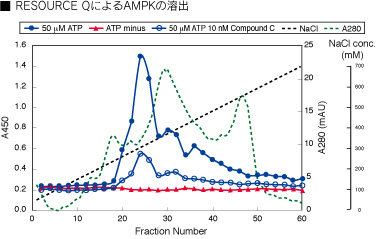CycLex AMPK Kinase Assay Kit
| Code | Size | Price |
|---|
| MBL-CY-1182 | 96 Assays | £603.00 |
Quantity:
Prices exclude any Taxes / VAT
Overview
Regulatory Status: RUO
Shipping:
4°C
Storage:
4°C
Images
Documents
Further Information
Applications:
Other - 1) Screening activators or inhibitors of AMPK.
2) Evaluating the effects of pharmacological agents on AMPK activity in vitro.
3) Monitoring the purification of AMPK activity.
Background:
AMP-activated protein kinase (AMPK) regulates cellular energy metabolism by phosphorylation of key enzymes in metabolic pathways, such as acetyl?coenzyme A carboxylase (ACC) (1) or mTOR (mammalian target of rapamycin) (2), by modulating their activities, and by regulating the activity of transcription factors (3) and transcriptional cofactors (4). Its functions have been extensively studied in muscles and liver. AMPK stimulates pathways, which increase energy production (glucose transport, fatty acid oxidation) and switches off pathways, which consume energy (lipogenesis, protein synthesis, gluconeogenesis). Activation of AMPK in adipose tissue can be achieved through situations such as fasting and exercise. Adiponectin and leptin as well as hypoglycaemic drugs are activators of adipose tissue AMPK. This activation probably involves changes in the AMP/ATP ratio, and the upstream kinase LKB1 (5). These results have led to the concept that AMPK has an interesting pharmaceutical potential in situations of insulin resistance (type 2 diabetes) and it is indeed the target of existing drugs, e.g. Metformin and hormones which improve insulin sensitivity.
Mammalian AMPK is a trimeric enzyme comprising a catalytic α subunit (63 kDa) and non-catalytic β and γ subunits (6, 7). Multiple isoforms of each mammalian enzyme exist (α1, α2, β1, β2, γ1, γ2, γ3), each encoded by a different gene. The β subunits have a calculated molecular mass of 30 kDa, but migrate on SDS-PAGE with apparent masses of 38 kDa (β1) and 34 kDa (β2), whereas the three γ isoforms have molecular masses of 37 kDa (γ1), 63 kDa (γ2) and 55 kDa (γ3) (8). While AMPK complexes containing α2 (the first catalytic isoform to be cloned) (9) predominate in skeletal and cardiac muscle (10), approximately equal levels of α1 and α2 complexes are present in the liver (11). In contrast, pancreatic islet β-cells largely express α1 complex activity (12, 13).
Description:
The CycLex Research CycLex AMPK Kinase Assay kit is primarily designed to measure the activities of purified AMP-activated protein kinase (AMPK) or recombinant AMPK for the rapid and sensitive evaluation of activators or inhibitors. The phospho-serine specific monoclonal antibody used in this assay kit has been demonstrated to recognize the phospho-serine 789 in mouse Insulin Receptor Substrate-1 (IRS-1), which is efficiently phosphorylated by AMPK. Additionally, column fractions of cultured primary cell, cell line, or tissue can be assayed for AMPK activity with the CycLex Research Product CycLex AMPK Kinase Assay kit if the appropriate dose of AMPK specific inhibitor e.g. Compound C is used.
Gene IDs:
Human: 5564 Mouse: 19079
Kit Components:
Microplate, 10X Wash Buffer, Kinase Buffer, 20X ATP, 20X DTT, Anti-phospho-mouse IRS-1 S789 Monoclonal Antibody (AS-4C4), HRP conjugated Anti-mouse IgG, Substrate Reagent, Stop Solution
Target:
AMPK
References
1. Sim ATR, Hardie DG. The low activity of acetyl-CoA carboxylase in basal and glucagon-stimulated hepatocytes is due to phosphorylation by the AMP-activated protein kinase and not cyclic AMP-dependent protein kinase. FEBS Lett. 233: 294 ?298, 1988
2. Bolster DR, Crozier SJ, Kimball SR, Jefferson LS. AMP-activated protein kinase suppresses protein synthesis in rat skeletal muscle through downregulated mTOR signaling. J Biol Chem. 277: 23977?23980, 2002
3. Kawaguchi T, Osatomi K, Yamashita H, Kabashima T, Uyeda K. Mechanism for fatty acids sparing effect on glucose-induced transcription: regulation of carbohydrate response element binding protein by AMP-activated protein kinase. J Biol Chem. 277: 3829 ?3835, 2001
4. Yang W, Hong YH, Shen XQ, Frankowski C, Camp HS, Leff T. Regulation of transcription by AMP-activated Protein Kinase. Phosphorylation of p300 blocks its interaction with nuclear receptors. J Biol Chem. 276: 38341?38344, 2001
5. Hardie, D.G. The AMP-activated protein kinase pathway: new players upstream and downstream. J. Cell Sci. 117:5479?5487, 2004
6. Stapleton, D., Woollatt, E., Mitchelhill, K. I., Nicholl, J. K., Fernandez, C. S., Michell, B. J., Witters, L. A., Power, D. A., Sutherland, G. R. and Kemp, B. E.; AMP activated protein kinase isoenzyme family: subunit structure and chromosomal location. FEBS Lett. 409: 452?456, 1997
7. Kemp, B. E., Stapleton, D., Campbell, D. J., Chen, Z. P., Murthy, S., Walter, M., Gupta, A., Adams, J. J., Katsis, F., van Denderen, B. et al.; AMP-activated protein kinase, super metabolic regulator. Biochem. Soc. Trans. 31: 162?168, 2003
8. Cheung, P. C. F., Salt, I. P., Davies, S. P., Hardie, D. G. and Carling, D.; Characterization of AMP-activated protein kinase gamma-subunit isoforms and their role in AMP binding. Biochem. J. 346: 659?669, 2000
9. Hardie, D. G. and Carling, D.; The AMP-activated protein kinase ? fuel gauge of the mammalian cell? Eur. J. Biochem. 246: 259?273, 1997
10. Stapleton, D., Mitchelhill, K. I., Gao, G., Widmer, J., Michell, B. J., Teh, T., House, C. M., Fernandez, C. S., Cox, T., Witters, L. A. and Kemp, B. E.; Mammalian AMP-activated protein kinase subfamily. J. Biol. Chem. 271: 611?614, 1996
11. Woods, A., Azzout-Marniche, D., Foretz, M., Stein, S. C., Lemarchand, P., Ferre, P., Foufelle, F. and Carling, D.; Characterization of the role of AMP-activated protein kinase in the regulation of glucose-activated gene expression using constitutively active and dominant negative forms of the kinase. Mol. Cell. Biol. 20: 6704?6711, 2000
12. da Silva Xavier, G., Leclerc, I., Salt, I. P., Doiron, B., Hardie, D. G., Kahn, A. and Rutter, G. A. ; Role of AMP-activated protein kinase in the regulation by glucose of islet beta-cell gene expression. Proc. Natl. Acad. Sci. U.S.A. 97: 4023?4028, 2000
13. Salt, I. P., Johnson, G., Ashcroft, S. J. and Hardie, D. G.; AMP-activated protein kinase is activated by low glucose in cell lines derived from pancreatic beta cells, and may regulate insulin release. Biochem. J. 335: 533?539, 1998



